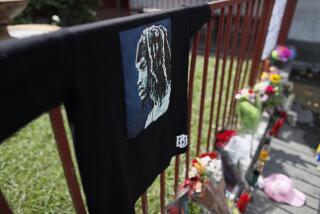Death Penalty Foes Mark a Milestone
- Share via
A former letter carrier who originally was sentenced to death for the 1991 murder of a cocktail waitress in Phoenix has been exonerated by DNA testing and freed from prison.
Ray Krone, 44, walked out of prison in Yuma, Ariz., late Monday after being incarcerated for a decade.
Krone has always maintained his innocence, despite being convicted twice of stabbing Kim Ancona to death on Dec. 29, 1991. Krone was initially sentenced to death in 1992. That sentence was overturned in 1995, but he was convicted again the following year and sentenced to life.
Although Krone was no longer on death row, a bevy of capital punishment foes--including Sen. Patrick J. Leahy (D-Vt.), the American Civil Liberties Union and the Justice Project--described Krone on Tuesday as the 100th person in this country who had been sentenced to death but eventually exonerated since executions resumed in the mid-1970s.
For every seven people executed in the U.S. in the last quarter century, one has been exonerated--an error rate that death penalty critics say is unacceptably high.
“Our nation this week reached an infamous milestone: 100 known--and goodness only knows how many unknown--cases of people being sentenced to death, since the reinstatement of capital punishment, for crimes they did not commit,” Leahy said.
“The time for denial is over. . . . Ray Krone lost 10 years of his life while Arizona’s women were endangered because the wrong man was in jail,” said Leahy, the chief sponsor of the Innocence Protection Act, a package of death penalty reforms.
“Justice has finally come,” Krone said in a telephone interview Tuesday. “The strength of knowing you are innocent” helped him get through 10 years in prison.
“And there was the strength I got from my friends and family. They never doubted I was innocent. They did everything they could to help me not get down.”
Krone said his cousin Jim Rix, a Lake Tahoe businessman whom he had never met before his murder conviction, came to visit him in prison and soon thereafter launched efforts that ultimately led to his exoneration.
Krone, an Air Force veteran who was working as a letter carrier at the time of his arrest, had no criminal record.
But Phoenix police focused on him within hours after Ancona’s naked, blood-spattered body with 11 stab wounds was found in a bathroom of the ABC Lounge on the morning of Dec. 29, when the bar owner went there for a meeting.
Krone lived just a few blocks from the bar and his phone number was in Ancona’s address book. Another woman who worked at the bar testified that Ancona told her that a man named “Ray” was coming late the night of Dec. 28 to help her close up.
Krone said he was home that night. His roommate confirmed that Krone had gone to bed about 10 p.m. but said he could not say for sure whether Krone had gone out later.
Krone frequently came to ABC Lounge to play darts. He testified that he was acquainted with Ancona but did not know her well.
A bite mark was found on the victim’s left breast and on her neck. Krone agreed to give police a dental impression by biting down on a plastic foam cup. Because of an earlier accident, Krone had a distinct bite pattern and a dentist helping police at the crime scene said Krone’s bite mark strongly resembled the one found on Ancona. Krone was later referred to as the “snaggletooth killer.”
The bite mark was the critical evidence at the trial. There were no fingerprints and there was no semen on Ancona, although there was evidence she had been sexually assaulted. All the blood at the crime scene was type O--the same type as Ancona and Krone and that of millions of other Americans. No DNA testing was done.
The key testimony in the case was presented by odontologist Ray Rawson, who testified that Krone’s bite mark matched the ones found on the victim. A jury convicted Krone of murdering Ancona in 1992 but acquitted him of sexual assault. A judge sentenced Krone to death, saying that the murder had been committed in an especially “heinous or depraved manner.”
Christopher Plourd, a San Diego attorney who specializes in cases involving complicated forensics, filed an appeal. It contended that the prosecutors had failed to turn over exculpatory evidence--a test done by another forensic odontologist that concluded Krone’s bite mark was not consistent with the one found on the victim.
The Arizona Supreme Court did not rule on that issue. Rather, in 1995, the state’s highest court reversed the conviction, saying that prosecutors had failed to turn over critical information--a videotape on the bite mark evidence prepared by Rawson that played a key role in the trial--until right before the trial began.
Krone was retried. Rawson testified for the prosecution again. Plourd presented contradictory testimony from other bite mark specialists, but Krone was convicted again in 1996. That time he got a life sentence.
Two years ago, Krone’s family hired another attorney, Alan M. Simpson of Phoenix, to work with Plourd. They requested DNA tests using sophisticated new technology. The initial tests conducted on saliva found on the victim’s tank top concluded that Krone could not have been the source.
Then, further tests were done, seeking to match the DNA found on the tank top with material in a state database of convicted sex offenders.
Those tests pointed strongly to Kenneth Phillips, 36, who already was in prison in Florence, Ariz., convicted of attempted child molestation.
On Monday, an attorney for the Maricopa County attorney’s office told a judge in Phoenix that the odds were 1.3 quadrillion to 1 that the DNA came from Phillips. In addition, prosecutors have found that Phillips, like the victim, has type O blood and that a dental expert has said he “cannot eliminate Phillips” as the person who left the bite mark, according to William Fitzgerald, a spokesman for the Maricopa County attorney’s office.
Maricopa County Superior Court Judge Alfred Frenzel released Krone, subject to a hearing scheduled for April 29 after police and prosecutors finish other testing. But Richard M. Romley, the Maricopa County attorney, indicated that he strongly believes the wrong man was convicted.
“Modern technology that was not available at the time of Mr. Krone’s convictions has provided new scientific evidence, which raise a serious question regarding Mr. Krone’s guilt,” Romley said.
Krone, who was a proponent of the death penalty before he was sent to prison, said he hopes his case will prompt people to reexamine the way the criminal justice system operates.
“I’m not the only one,” Krone said. “To make a mistake is one thing. It’s another thing how you correct it afterward.”
There are more than 100 people on death row in Arizona, and a special commission has been examining capital punishment there for more than a year.
Of the 100 death penalty exonerations around the country, six came from Arizona, according to a report by the Death Penalty Information Center in Washington, D.C., a group that opposes the death penalty.
And of the 100 exonerations, 12 came as a result of DNA testing. The Innocence Project at Cardozo Law School, co-founded by New York attorneys Peter Neufeld and Barry Scheck, played a key role in numerous DNA exonerations. Neufeld and Scheck said the Krone case showed both the power of DNA testing and the faulty nature of bite mark evidence.
Michael J. Saks, a professor at Arizona State University Law School, who coauthored a book on forensic evidence, said bite mark testimony is “classic junk science.” He said a recent study by the American Board of Forensic Odontologists found that 63.5% of bite mark analyses generated “false positives” and that another 22% turned out to be false negatives.
“At an absolute minimum,” Saks said, “jurors should be informed of the relative accuracy or inaccuracy of these tests so they don’t think there is more to them than there is.”
More to Read
Sign up for Essential California
The most important California stories and recommendations in your inbox every morning.
You may occasionally receive promotional content from the Los Angeles Times.










